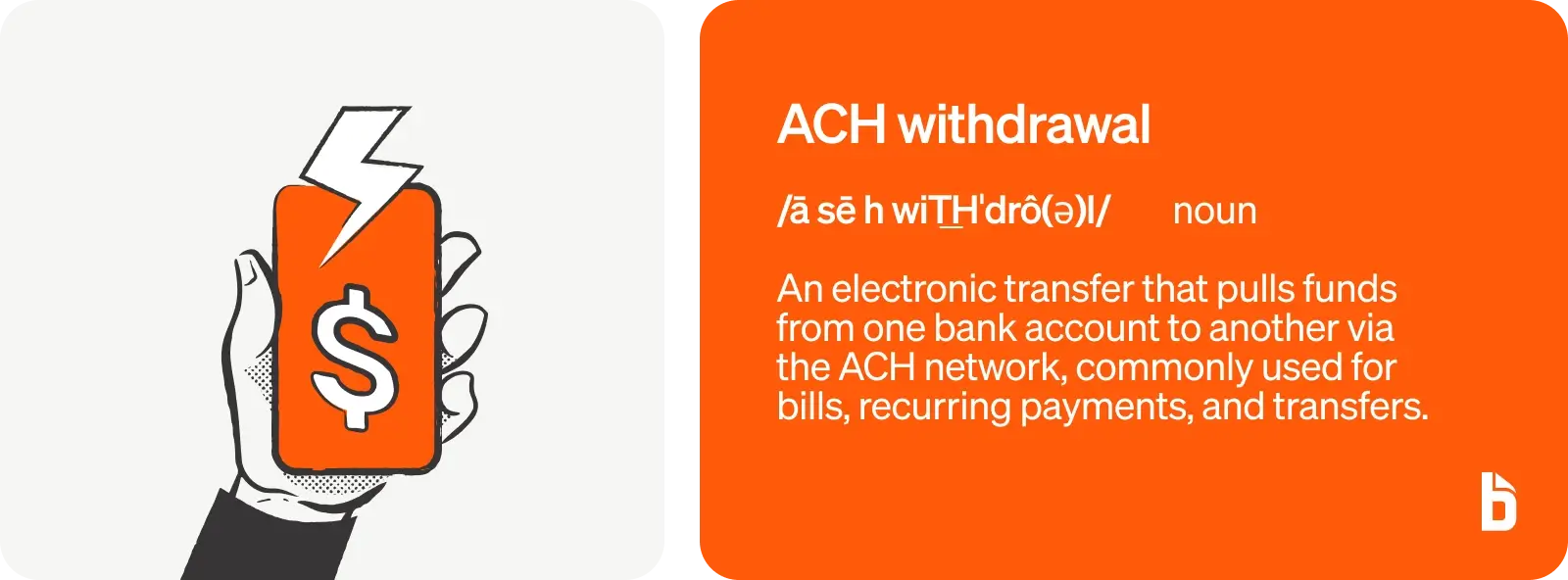Sending and receiving money has never been easier. With many options available, businesses and their customers can pick the payment option that works best for them.
ACH withdrawals are a tried and true option that’s been around since 1972. It’s stuck around because it’s reliable, efficient, and more accessible than ever before.
Read on for what you need to know about making ACH withdrawals and whether you should start accepting them.

What is an ACH withdrawal?
ACH withdrawals are electronic transactions that pull funds from one financial account and place them in another. Payment methods—such as bill payments, direct deposits, recurring payments, and any transfers from one bank account to another—are all considered ACH withdrawals.
The letters "ACH" stand for Automated Clearing House, a secure network of banks in the United States, including the Federal Reserve, that allows fast, easy electronic payments between parties, even if you don't share the same financial institution.
Individuals and businesses use the ACH network to receive payments quickly for everything from recurring bill payments to tax refunds.
How does ACH withdrawal work?
In most cases, companies use ACH withdrawals to accept payments directly from clients or customers for products and services—whether those customers are businesses or individuals.
There are two types of ACH transfers: ACH credit or ACH debit. A credit is a withdrawal initiated by the payer, while a debit is initiated by the receiver. For now, we'll focus on ACH credits.
Here's how it works.
An ACH withdrawal is requested. The customer submits their banking information to the vendor or their payment processor. Necessary banking information includes a routing number and bank account number.
The request is then submitted to the bank. A withdrawal request with transaction details is submitted to the customer's bank. They pass on the customer's account information and verification that a withdrawal is authorized.
The bank adds the ACH withdrawal to the queue. The ACH network contains a queue of ACH transactions cleared out regularly on business days. If a withdrawal is triggered late on a Friday, it might not be processed until Monday.
The ACH withdrawal is processed. An ACH operator reviews queued transactions before being approved and submitted to the banks.
The money is routed to the receiving bank. The transaction is processed with the funds directed to the merchant's financial institution and deposited in their account.

The costs of ACH transactions are incredibly reasonable, often lower than credit card transaction fees, and the service benefits both the business and the consumer:
- The company gets its recurring payments without any manual work by the accounting or finance departments
- The customer benefits from automated payments, always meeting their payment terms and avoiding late fees
Many types of businesses offer the option to pay by ACH—utility companies, mortgage lenders, banks providing loans, and any other business that takes recurring payments.
How do ACH and direct deposit work?
Direct deposits are initiated by the person or company making the payments. In other words, instead of pulling money in, they push money out.
For example, the US government makes social security payments and offers electronic tax refunds through direct deposit.
An ACH direct deposit can be a one-time or recurring payment, depending on what's needed. A business might deposit monthly employee paychecks directly into personal checking accounts. Or it might issue individual payments to corporate merchants as a matter of convenience.
Either way, the process is similar to an ACH withdrawal. The person getting paid provides their banking information and approves the transfer. The sender makes the timely payment automatically.
How to make an ACH withdrawal
You can make an ACH withdrawal in 4 simple steps:

- Set your business up on an ACH provider.
- Get written or recorded consent from your customer, allowing you to make a one-time or recurring ACH withdrawal.
- Enter your customer's information into your ACH payment processor. This includes the legal name the bank account is under, the bank name, routing number, and bank account number (all of this can be found on a check).
- Submit the one-time or recurring ACH withdrawal request for the agreed-upon amount.
The most work for an ACH withdrawal happens at the initial setup. Once the verification and account information are submitted, the ACH withdrawal process is as easy as getting confirmation from your client and submitting the transfer request.
ACH withdrawal: pros and cons
Overseen by the National Automated Clearing House Association (NACHA), the ACH network moves trillions of dollars in electronic funds transfers from checking and savings accounts every year.
If you want to transfer money electronically within the U.S., ACH transactions are secure, fast, and convenient, and they have very few limitations:
- ACH payments aren't always available for international transfers
- Standard ACH payments take 2–5 business days to clear
- Same-day payment amount has a limit of $100,000
Funds are usually sent by international wire transfers for larger same-day and international payments. (If you need to send international wire transfers, BILL does that too—with no wire transfer fee* for payments to vendors in local currencies.)
ACH withdrawals with BILL
BILL makes sending and receiving payments through the ACH network securely. The payer and payee submit their information, and it's kept secure—payments are completed without sharing your banking information.
But it doesn't stop at ACH withdrawals. Make virtual card payments, international wire transfers, and even paper checks, all from the easy-to-use dashboard.
By automating and streamlining the AP process, BILL customers reported saving 50% of their AP time on average.
Want to learn more? Get started and see for yourself, or request a demo with one of our product experts.


